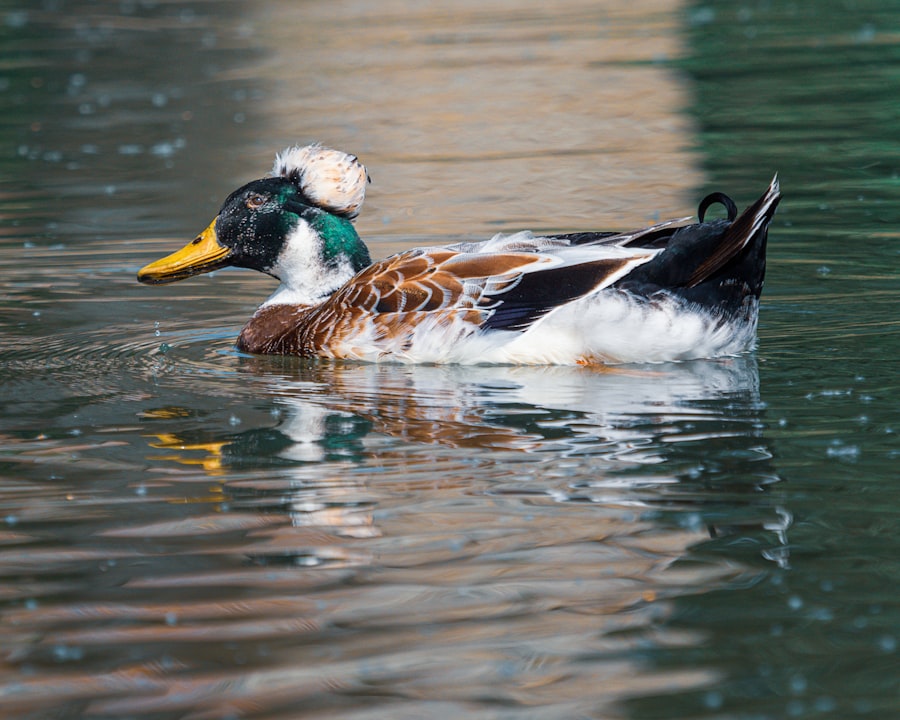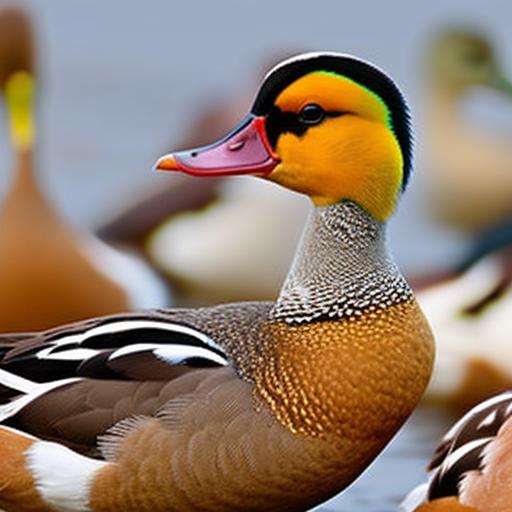Duck meat is a delicious and nutritious alternative to traditional poultry options like chicken and turkey. Raising ducks for meat production has become increasingly popular among farmers and homesteaders due to the many advantages it offers. In this article, we will explore different duck breeds that are ideal for meat production, their characteristics, and tips for raising them successfully.
Key Takeaways
- Pekin ducks are the most popular breed for meat production.
- Muscovy ducks are a lean and tasty alternative to Pekin ducks.
- Rouen ducks are a classic French meat breed with flavorful meat.
- Aylesbury ducks are a traditional British meat breed with tender meat.
- Khaki Campbell ducks are an egg-laying meat breed that produces lean meat.
Pekin Ducks: The Most Popular Meat Breed
Pekin ducks are the most popular breed for meat production. They are large, white-feathered ducks with a plump body and a mild flavor. Pekin ducks are known for their high meat-to-bone ratio, making them an excellent choice for those looking to maximize their meat yield.
One of the advantages of raising Pekin ducks for meat is their fast growth rate. They reach market weight in just 7-9 weeks, making them a cost-effective option for farmers. Pekin ducks are also known for their docile temperament, which makes them easy to handle and manage.
When raising Pekin ducks, it is important to provide them with a clean and spacious environment. They require access to water for swimming and cleaning themselves, as well as a balanced diet consisting of grains and protein-rich feeds.
Muscovy Ducks: The Lean and Tasty Alternative
Muscovy ducks are another popular breed for meat production. Unlike other duck breeds, Muscovy ducks have less fat and a leaner meat, making them a healthier option. Their meat is often compared to that of beef or veal in terms of taste and texture.
One of the advantages of raising Muscovy ducks for meat is their ability to forage for food. They are excellent at finding their own food sources, which can help reduce feed costs. Muscovy ducks also have a higher feed conversion ratio compared to other duck breeds, meaning they require less feed to produce a pound of meat.
When raising Muscovy ducks, it is important to provide them with a spacious and secure environment. They are excellent flyers and can roost in trees, so it is important to have proper fencing or enclosures to keep them safe. Muscovy ducks also require a balanced diet consisting of grains, greens, and protein-rich feeds.
Rouen Ducks: The Classic French Meat Breed
Rouen ducks are a classic French breed known for their flavorful meat. They have a plump body and a rich, gamey flavor that is highly sought after by chefs and food enthusiasts. Rouen ducks are larger than Pekin ducks but have a similar growth rate, reaching market weight in 8-10 weeks.
One of the advantages of raising Rouen ducks for meat is their versatility in the kitchen. Their flavorful meat can be used in a variety of dishes, from traditional roast duck to confit and cassoulet. Rouen ducks also have a good feed conversion ratio, making them an efficient option for meat production.
When raising Rouen ducks, it is important to provide them with a clean and spacious environment. They require access to water for swimming and cleaning themselves, as well as a balanced diet consisting of grains and protein-rich feeds.
Aylesbury Ducks: The Traditional British Meat Breed
Aylesbury ducks are a traditional British breed known for their tender and succulent meat. They have a white-feathered body and a plump breast, making them an attractive option for meat production. Aylesbury ducks have a slower growth rate compared to other breeds, reaching market weight in 12-14 weeks.
One of the advantages of raising Aylesbury ducks for meat is their excellent flavor and texture. Their meat is tender and juicy, making it ideal for roasting or grilling. Aylesbury ducks also have a good feed conversion ratio, meaning they require less feed to produce a pound of meat.
When raising Aylesbury ducks, it is important to provide them with a clean and spacious environment. They require access to water for swimming and cleaning themselves, as well as a balanced diet consisting of grains and protein-rich feeds.
Khaki Campbell Ducks: The Egg-Laying Meat Breed

Khaki Campbell ducks are a versatile breed that is known for both their egg-laying abilities and their meat production. They have a slender body and a rich, flavorful meat. Khaki Campbell ducks have a fast growth rate, reaching market weight in 8-10 weeks.
One of the advantages of raising Khaki Campbell ducks for meat is their ability to lay a large number of eggs while also producing quality meat. This makes them a cost-effective option for farmers who are looking to maximize their production. Khaki Campbell ducks also have a good feed conversion ratio, making them an efficient option for meat production.
When raising Khaki Campbell ducks, it is important to provide them with a clean and spacious environment. They require access to water for swimming and cleaning themselves, as well as a balanced diet consisting of grains and protein-rich feeds.
Silver Appleyard Ducks: The Dual-Purpose Meat Breed
Silver Appleyard ducks are a dual-purpose breed that is known for both their egg-laying abilities and their meat production. They have a plump body and a flavorful meat that is often compared to that of Pekin ducks. Silver Appleyard ducks have a moderate growth rate, reaching market weight in 10-12 weeks.
One of the advantages of raising Silver Appleyard ducks for meat is their versatility in the kitchen. Their flavorful meat can be used in a variety of dishes, from traditional roast duck to stir-fries and curries. Silver Appleyard ducks also have a good feed conversion ratio, making them an efficient option for meat production.
When raising Silver Appleyard ducks, it is important to provide them with a clean and spacious environment. They require access to water for swimming and cleaning themselves, as well as a balanced diet consisting of grains and protein-rich feeds.
Magret Ducks: The Specialty Meat Breed for Foie Gras
Magret ducks are a specialty breed that is primarily raised for foie gras production. They have a large, flavorful breast that is highly prized in French cuisine. Magret ducks have a slower growth rate compared to other breeds, reaching market weight in 12-14 weeks.
One of the advantages of raising Magret ducks for meat is the unique flavor and texture of their meat. Their breast meat is rich and tender, making it ideal for searing or grilling. Magret ducks also have a good feed conversion ratio, meaning they require less feed to produce a pound of meat.
When raising Magret ducks, it is important to provide them with a clean and spacious environment. They require access to water for swimming and cleaning themselves, as well as a balanced diet consisting of grains and protein-rich feeds.
Choosing the Right Duck Breed for Your Meat Production
When choosing a duck breed for meat production, there are several factors to consider. First, consider the flavor and texture of the meat you prefer. Some breeds, like Pekin ducks, have a mild flavor and tender meat, while others, like Muscovy ducks, have a leaner and more gamey flavor.
Second, consider the growth rate of the breed. If you are looking for a fast-growing breed that reaches market weight quickly, breeds like Pekin ducks or Khaki Campbell ducks are good options. If you are willing to wait longer for a larger bird with more flavorful meat, breeds like Rouen ducks or Aylesbury ducks may be more suitable.
Lastly, consider your own preferences and resources. Some breeds, like Muscovy ducks, are excellent foragers and require less feed, while others, like Pekin ducks, require more space and a balanced diet. Consider the space you have available, the feed costs, and the amount of time and effort you are willing to invest in raising ducks for meat.
Raising and Caring for Your Meat Ducks: Tips and Best Practices
When raising meat ducks, there are several tips and best practices to keep in mind. First, provide your ducks with a clean and spacious environment. Ducks require access to water for swimming and cleaning themselves, so make sure they have a suitable water source. Provide them with a balanced diet consisting of grains and protein-rich feeds to ensure their growth and health.
Second, make sure your ducks have proper housing and protection from predators. Ducks are vulnerable to predators like foxes and raccoons, so it is important to have secure fencing or enclosures to keep them safe. Provide them with adequate shelter from the elements, such as a well-ventilated coop or shed.
Lastly, monitor your ducks’ health and well-being regularly. Look out for signs of illness or distress, such as loss of appetite, lethargy, or abnormal behavior. Provide them with regular veterinary care and vaccinations to prevent diseases.
Raising ducks for meat production can be a rewarding and profitable venture. Whether you choose Pekin ducks for their fast growth rate, Muscovy ducks for their lean meat, or Rouen ducks for their classic flavor, there is a breed that suits your preferences and resources. By providing them with a clean environment, a balanced diet, and proper care, you can raise healthy and delicious meat ducks on your farm or homestead. So why not give it a try?
If you’re interested in learning more about duck breeds for meat, you might also find this article on “What Should You Feed Ducks?” from Poultry Wizard to be helpful. It provides valuable information on the proper diet and nutrition for ducks, which is essential for their growth and development. Understanding the right feeding practices can greatly contribute to raising healthy and high-quality ducks for meat production. Check out the article here to enhance your knowledge on this topic.
FAQs
What are the best duck breeds for meat?
The best duck breeds for meat are Pekin, Muscovy, and Rouen. These breeds are known for their meat quality and quantity.
What is the difference between Pekin and Muscovy ducks?
Pekin ducks are a domesticated breed that originated in China, while Muscovy ducks are a wild breed that originated in South America. Pekin ducks have a milder flavor and are more tender, while Muscovy ducks have a richer flavor and firmer texture.
What is the average weight of a mature duck for meat?
The average weight of a mature duck for meat is around 5-6 pounds.
What is the ideal age to slaughter ducks for meat?
The ideal age to slaughter ducks for meat is around 7-9 weeks old. At this age, they have reached their maximum weight and their meat is tender and flavorful.
What is the nutritional value of duck meat?
Duck meat is a good source of protein, iron, and vitamin B. It is also lower in fat than other meats like beef and pork.
What is the best way to cook duck meat?
The best way to cook duck meat is to roast it in the oven or grill it. It is important to cook it to an internal temperature of 165°F to ensure it is safe to eat.
Meet Walter, the feathered-friend fanatic of Florida! Nestled in the sunshine state, Walter struts through life with his feathered companions, clucking his way to happiness. With a coop that’s fancier than a five-star hotel, he’s the Don Juan of the chicken world. When he’s not teaching his hens to do the cha-cha, you’ll find him in a heated debate with his prized rooster, Sir Clucks-a-Lot. Walter’s poultry passion is no yolk; he’s the sunny-side-up guy you never knew you needed in your flock of friends!







